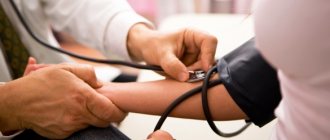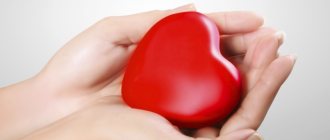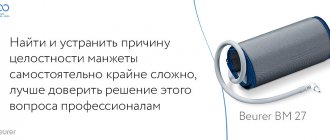Currently, arrhythmias are quite common. There are frequent cases of their combination with hypotension (low blood pressure), which aggravates the condition of patients and requires an integrated approach to diagnosis and treatment. It is important to understand that there are a large number of different types and forms of arrhythmias that have completely different causes. Any disruption of the heart is a serious symptom; they can be classified as so-called “red signs”, especially if we are talking about an acute arrhythmia, which is accompanied by a decrease in blood pressure. Therefore, the answer to the question: “I have arrhythmia and low blood pressure, what should I do?” – there will be a timely request for help from a specialist: family doctor, therapist, cardiologist.
Self-administration of drugs that affect the heart rhythm can lead to even more serious disorders, worsening heart failure and even death.
Reasons for lowering blood pressure during arrhythmias
Arrhythmia is a condition in which the normal functioning of the heart is disrupted. In this case, the heart rate may change; depending on this, tachyarrhythmias (with an increase in the number of heartbeats) and bradyarrhythmias (with a decrease in heart rate) are distinguished. In other cases, the process of cardiac contraction itself suffers: it proceeds incorrectly, which entails impaired blood circulation through the chambers of the heart, a decrease in cardiac output and minute volume of blood circulation. There are also cases of distortion of the act of contraction in combination with changes in heart rate.
Blood pressure is directly proportional to heart rate, the tone of the vascular walls, and minute volume of blood circulation (the product of cardiac output per contraction per heart rate). Thus, blood pressure directly depends on the etiological factor of the arrhythmia itself.
Causes of arrhythmias with hypotension:
- frequent stress;
- bad habits (smoking, alcohol, taking drugs);
- overwork and excessive physical activity;
- sleep disorders;
- avitaminosis;
- pregnancy;
- taking medications that affect heart rhythm;
- inflammatory processes in the cardiovascular system;
- imbalance of basic electrolytes in blood plasma;
- diseases of the thyroid gland (thyrotoxicosis, hypothyroidism);
- disruption of the adrenal cortex;
- osteochondrosis changes in the cervical spine;
- hypoglycemic conditions and others.
Here are the most common causes of arrhythmias and hypotension. There are paroxysmal arrhythmias, which take a very short period of time and occur in the form of attacks.
Treatment
Treatment of tachycardia with hypotension depends on the reasons that provoked the pathological changes. Typically, drugs that slow your heart rate also lower your blood pressure. Therefore, the therapy of the pathology is complex and consists of a whole range of means. Taking any medications on your own is strictly prohibited.
The patient must not only take the prescribed medications, but also follow the doctor’s recommendations. You need to follow a daily routine and a special diet, and avoid stress. You should stop smoking and drinking alcoholic beverages.
Experienced specialists at the medical center in Lyublino treat tachycardia due to hypotension. Doctors have extensive experience and successfully cope with pathology. To make an appointment and for more information, please call.
All articles
5% discount Print coupon from our website
Ask your question on the website Get professional advice!
Normal heart rate and blood pressure
A normal heart rate is between 60 and 80 beats per minute. Anything more is called tachycardia, and if the heart rate is below 60 beats per minute - bradycardia. It is worth noting that a slower heart rate can be observed in athletes, and this is a variant of the norm.
Normal blood pressure values for systolic are 100-130 mmHg, for diastolic – 65-85 mmHg. Hypotension is a blood pressure below 100/60 mmHg. However, there may be individual characteristics, for example, in short people, normal blood pressure can be in the range of 100-105/60 mmHg. and for them this will be a variant of the norm.
Symptoms
Patients with hypotension due to arrhythmias present with a variety of complaints. They are worried about lethargy, fatigue, dizziness, tinnitus, darkening of the eyes, and intense headache. Some experience fainting and loss of consciousness, especially when changing body position, standing up suddenly, and so on.
Hypotonic people react very sensitively to changes in weather conditions, feel strong sweating on the palms of their hands, and their joints may also hurt.
From the side of the heart, patients feel interruptions in its work, palpitations. There may be pain in the area of the heart that is pressing, squeezing, or pulling. They can last for several days. Specific to this pain syndrome is that there is no effect from taking nitroglycerin. On the contrary, its use can aggravate heart pain.
The pain of hypotension with arrhythmia does not increase with physical activity, and in some people the condition improves after increasing activity.
Arrhythmia at low pressure can cause shortness of breath and heart failure. It often manifests itself in the form of edema (of the lower third of the legs). Arrhythmia and hypotension due to myocardial infarction will cause acute circulatory failure, leading to pulmonary edema and possible death.
Medications
To prescribe effective treatment for arrhythmia and low blood pressure, it is necessary to find out their root cause. If the diseases are caused by pathologies of the autonomic nervous system or constant stress, then sedatives are prescribed. If the disease is organic in nature, then tranquilizers are more effective than conventional sedatives. But they are taken under the strict supervision of a doctor, in a hospital.
Attention! In total, there are three groups of drugs that are prescribed by a cardiologist to normalize heart rhythm and blood pressure.
Sedatives
The peculiarity of sedatives is that they can be used without a doctor’s prescription for preventive purposes. With the help of sedatives, blood pressure is normalized and heart rhythm is restored. Attacks of insomnia cease to bother you, and general emotional tension is relieved.
After using sedatives, nervousness is slightly reduced, without dependence or drowsiness.
Sedatives have a combined composition. Among the components: bromides, herbal medicinal preparations and barbiturates. As already noted, the most popular sedatives for low blood pressure and heart rhythm disturbances are motherwort and valerian.
These sedatives are used for preventive purposes to relieve emotional stress. To do this, motherwort is taken 30-50 drops with 50 ml of plain water. It is undesirable to take such drugs if a person does not experience obvious discomfort.
Tranquilizers
If a person is intolerant to antiarrhythmic drugs, then treatment is carried out using tranquilizers. They are used to restore heart rhythm. Tranquilizers differ from sedatives in that they lower blood pressure and reduce heart rate during tachycardia.
The use and dosage of tranquilizers is only as prescribed by the attending physician. Among the drugs used are Diazepam, Elenium and Phenazepam. If pathological changes in the heart cause a rhythm disturbance, then, in addition to relieving the arrhythmia, you need to treat the underlying disease. A competent doctor, as a rule, will be able to reduce the dosage while still leaving the therapy effective.
Read also: What to do in case of cardiac arrhythmia at home, algorithm of actions
Antiarrhythmic
A group of these drugs are used to normalize heart rhythm. In this case, antiarrhythmic drugs will not be prescribed if the patient needs to relieve pain or reduce the likelihood of recurrence of arrhythmia. With the help of antiarrhythmic drugs, the conductivity of the heart muscle is improved and metabolic processes are restored.
Typically, the following antiarrhythmic drugs are prescribed:
- Aymalin.
- Ethacizin.
- Pulse norm.
- Novocainamide.
- Quinidine.
- Rhythmonorm.
In this case, the attending physician selects the drug and dosage, assessing the severity of the disease. All instructions and prescriptions of the cardiologist or arrhythmologist must be followed in full. To maintain effectiveness, do not stop taking it prematurely or reduce the dose. Because in this case the risk of relapse increases.
What to do
The patient is able to help himself even before the ambulance arrives. What kind of help you should give yourself depends on what exactly the patient feels.
With paroxysmal tachyarrhythmia, the patient notices a sharp attack with an increase in heart rate.
It is important to know how to reduce your heart rate. In this case, you should start with specific tests:
- Aschner's test (pressure on the eyeballs);
- Valsalva maneuver (otherwise called a straining test, the patient does this procedure several times);
- pressing on the upper abdomen (to stimulate the solar plexus, which activates the parasympathetic nervous system).
Let's take drugs such as Corvalol, Valocordin. These drugs slow your heart rate. If the attack is accompanied by a feeling of fear, it is better to give preference to Barboval.
If the patient is fixed on his complaints, has any psycho-emotional disorders, it is rational to use sedatives such as valerian tincture.
This and other forms of arrhythmias often develop in people who abuse loop diuretics: Furosemide, Torasemide, Lasix. They gradually reduce the concentration of potassium in the blood, which can cause arrhythmia. Therefore, the patient should take a Panangin or Asparkam tablet before the ambulance arrives, which can somehow compensate for the concentration of reduced potassium.
In case of a clear drop in heart rate and hypotension, you can take a caffeine tablet or citramon. In addition, Zelenin tincture is widely used in such cases.
Arrhythmia and hypertension - symptoms
High blood pressure is often accompanied by heart rhythm disturbances. This happens because the circulation of a large volume of blood causes an increase in the volume of the ventricles. Therefore, with hypertension, the heartbeat rhythm is also disrupted.
The occurrence of arrhythmia and hypertension can be associated with complications of paroxysmal tachycardia. Additional foci of nerve impulses cause untimely contractions of the heart muscle. The impulses can cause a temporary stop of cardiac activity, turning into strong heartbeats.
If arrhythmia is accompanied by high blood pressure, then there is a high risk of complications. Simultaneous disruption of the functioning of the heart muscle and blood vessels is a serious pathology, which indicates morphological changes in the entire cardiovascular system, leading to ventricular fibrillation.
To reduce the severity of an attack of tachycardia, you can act on the vagus nerve. You can do this yourself as follows:
- Press on the eyeballs with your thumbs.
- Massage in the area of the carotid artery.
- Induce a gag reflex.
These are simple and effective methods. If they did not help, then you need to urgently call for medical help.
Attention! With high blood pressure and atrial fibrillation, left ventricular failure develops. This leads to tachycardia and other rhythm disturbances. In some cases, a gallop rhythm appears.
General principles of treatment of arrhythmias with hypotension
General principles include normalization of work and rest schedules, correction of sleep disorders, and giving up bad habits. It is necessary to spend more time in the fresh air, have a sufficient level of physical activity, but nevertheless not overwork, avoid exposure to harmful factors on your body, and take complex vitamin preparations in the autumn-spring period. Following these rules will quickly help restore your heart rhythm at the first sign of disturbance.
Active trophic therapy is also carried out to improve the supply of nutrients and oxygen to the heart muscle and other organs. Correction of metabolic disorders is another important step in the treatment of arrhythmias and hypotension. The following medications are used for this:
- Mildronate (Metamax);
- Tivortin;
- Thiotriazolin;
- Panangin (Asparkam);
- Piracetam (Tiocetam);
- Preducted.
The remaining groups of drugs that act on the heart rhythm are prescribed solely according to indications, after a comprehensive examination by a medical specialist, and are administered under strict control, usually in an inpatient setting. Therapy with these drugs involves dynamic monitoring of the patient's condition.
Heart arythmy
What is cardiac arrhythmia?
Arrhythmia is a disorder of the heart rhythm. The main reasons causing the failure are:
- intoxication of the body as a result of drinking alcohol, drugs and smoking;
- stress;
- vasoconstriction;
- lack of hemoglobin in the blood;
- strong adrenaline rush;
- electrolyte imbalance;
- heart disease (heart failure, heart attack, heart muscle defect);
- hormonal imbalance;
- physical and mental exhaustion.
The main causes of heart rhythm disturbances include:
- Congenital or acquired heart defect.
- A person has chronic heart failure.
- Cardiac ischemia.
- Hereditary cardiomyopathy.
- Hypertonic disease.
Symptoms of arrhythmia
The main symptoms of arrhythmia are: 1. Tachycardia. This is a rapid heartbeat (above 90 beats per minute). 2. Bradycardia. Decreased heart rate (less than 50 beats). 3. Extrasystole. Irrhythmic heartbeat (untimely contraction of the heart chambers). 4. Atrial fibrillation. A type of tachycardia manifested by atrial fibrillation. 5. AV block. A type of bradycardia characterized by a disturbance in the conduction of impulses from the atria to the ventricles.
Prevention of cardiac arrhythmia should be carried out only after consultation with a doctor, who will accurately determine whether there is a malfunction in the rhythm of the heart muscle and what caused it.
When arrhythmia occurs, a person's heart rate changes. Rhythm disturbances are quite rarely an independent disease. In most cases, arrhythmia signals the presence of various heart diseases in a person.
When talking about cardiac arrhythmia, it is important to remember the danger of this disease. And the best solution would be timely prevention of cardiac arrhythmia. It is very important to take this measure seriously, since about 35–40% of sudden deaths occur due to asymptomatic cardiac arrhythmia. Prevention of a disease such as cardiac arrhythmia must begin with the treatment of cardiovascular diseases. After all, heart rhythm disorder often begins precisely because of more serious illnesses. When starting a course of treatment, it is important to give up bad habits (alcohol) forever.
Cardiac arrhythmia is not a death sentence, but a disease that is a violation of the frequency, sequence and rhythm of heart contractions. The disease can be determined only after examination using an ECG device and ultrasound examination of the heart.
Causes of arrhythmia. Provocateurs of the disease for completely healthy people can be excessive consumption of food, tight clothing, medications, constipation, insect bites, and stressful situations. For people with diabetes, overweight and high blood pressure, the risk of heart arrhythmia increases.
Symptoms of arrhythmia. As a rule, heart arrhythmia disease corresponds to the following symptoms: slow, or vice versa, too fast heartbeat; missed or extra heart beats; frequent fatigue, a state of weakness of the body, shortness of breath, pain in the heart.
Folk remedies for the treatment of arrhythmia. Cardiologists do not recommend using traditional medicine advice for arrhythmia. Why? Do not forget that arrhythmia is a disease of the heart, an organ vital to humans. It is necessary to quickly make a correct diagnosis and prescribe competent treatment. Folk remedies for arrhythmia, as medical practice shows, are powerless.
Prevention of arrhythmia. To reduce the likelihood of developing arrhythmia, try to maintain an active lifestyle: engage in recreational and therapeutic exercise, take walks in the fresh air, and try not to overwork yourself with work. Prevention of arrhythmia is also a timely visit to the doctor. As soon as you feel the first signs of the disease, or you simply have suspicions, contact a medical facility.
Treatment of arrhythmia. Treatment of arrhythmia is carried out in conjunction with antiarrhythmic procedures. It is worth remembering that there are a large number of types of arrhythmia. The type of treatment, the use of various drugs and procedures depends on the type of disease.
Most importantly, do not despair and be pessimistic about treatment. Arrhythmia is cured. You just need to follow the doctor’s recommendations, take medications on time, and devote more time to physical activity.
Sports to prevent arrhythmia
A person does not need to exhaust himself with unbearable physical activity. You can go swimming or jog for short distances. When skiing or performing simple gymnastic exercises, the condition of the cardiovascular system noticeably improves.
You can do simple physical exercises such as push-ups or squats. Squats help improve vascular tone and activate blood circulation in the body. The main rule is that when performing the exercise you need to keep your back straight.
The body must adapt to physical activity. Over time, a person will be able to move on to more complex exercises.
Maintaining a balanced diet
If you have heart rhythm disturbances, reconsider your diet. Eliminate fats and foods that are too salty, smoked, or spicy from your food. Give preference to fresh vegetables, fruits, and whole grain cereals. In the diet, pride of place is given to products containing vitamins and microelements necessary for the heart muscle. A person should give preference to products containing potassium and magnesium. These beneficial microelements have a beneficial effect on the cardiovascular system.
The heart needs potassium, magnesium, zinc, and calcium to properly pump blood. A large amount of potassium is found in bananas, sunflower seeds, and potatoes baked in their jackets.
Dairy and fermented milk products are considered a source of calcium. It is useful to include in your diet sesame seeds, rich in zinc, buckwheat porridge, legumes, various nuts, currants, beets baked in the oven, and corn. All these products have a positive effect on the functioning of the heart muscle. The body's need for magnesium and potassium increases under the influence of various factors. These include: hard physical work, overwork, stress, increased sweating, mental overstrain.
Foods rich in potassium and magnesium are listed in table No. 1
| Foods high in potassium | Magnesium Rich Foods |
| Potato | Cocoa |
| Cabbage | Bran |
| Carrot | Sesame seeds |
| Bananas | Shrimps |
| Dried apricots | Nuts |
| Raisin | Peas |
| Prunes | Sea kale |
| Dates | Beans |
| A person's diet should consist of vegetables, fruits and whole grains. Overeating should be avoided. | |
A person who is predisposed to arrhythmia should also give up alcoholic beverages. They contribute to a sharp contraction of blood vessels: this negatively affects the functioning of the cardiovascular system.
Drugs for the prevention of cardiac arrhythmia
Folk remedies and changing eating habits help normalize heart rhythm. If heart rhythm disturbances are associated with mental causes or depressive states, then sedatives are prescribed for treatment. For preventive purposes, products can be purchased without a doctor's prescription.
Amiodarone
Helps quickly relieve an attack of arrhythmia and is suitable as maintenance therapy to prevent heart rhythm disturbances. Indicated for atrial flutter, atrial fibrillation, and sinus tachycardia. The drug is indicated for severe arrhythmia in combination with heart failure and coronary heart disease. The drug is contraindicated for arrhythmia in combination with atrioventricular block. Patients tolerate the medicine well, side effects are rare. Amiodarone is used for prophylaxis at 200–400 mg per day, dividing this dose into 3 doses. The course lasts 7–14 days.
Quinidine
The membrane stabilizing drug is intended for the prevention of atrial fibrillation and ventricular fibrillation. Lowers blood pressure, weakens myocardial function. The daily dose of the drug is 3 grams. It is divided into 4–5 doses. The drug is not used in cases of quinine intolerance, or in combination with Verapamil and anticoagulants.
Procainamide
Take the drug to prevent arrhythmia at 250–500 mg several times a day (the maximum daily dose is 4 grams). Contraindicated in bronchial asthma, severe disorders of the kidneys, liver, atherosclerosis and after myocardial infarction.
Ibutilide Sotalol
Beta blocker. Suitable for the prevention of tachyarrhythmia. The daily dose is 80 grams. The drug has a low distribution in tissues and organs, therefore it is suitable for the prevention of arrhythmia in patients with liver and kidney diseases.
Verapamil
Prevention of atrial fibrillation is often carried out with the use of this drug. Take it several times a day with meals. The prophylactic dose is 48 mg. Do not use the drug with other antiarrhythmic drugs, in the presence of hypotension, heart failure in the stage of decompensation.
Panangin
It is used to prevent arrhythmia, including those caused by an overdose of cardiac glycosides as a means of replenishing the deficiency of potassium and magnesium. Prescribe 1-2 tablets 3 times a day. The preventive course is 3–4 weeks. Contraindications include pregnancy and lactation, low blood pressure, and dehydration.
Anaprilin
A popular antiarrhythmic adrenergic blocker, which contains propranolol. A single dose of the product should not exceed 80 grams. Take the drug twice a day. Contraindications to taking the drug are bradycardia, chronic heart failure, intolerance to propranolol.
Metoprolol
A beta blocker, which is prescribed for the prevention of arrhythmia, coronary heart disease, and high blood pressure. For prevention, it is recommended to take 1 tablet twice a day. Contraindications are: bradycardia, persistent hypertension, angina pectoris, age under 18 years, period of pregnancy and lactation. Treatment of atrial fibrillation should be carried out only under the guidance of a doctor, since this condition seriously threatens the patient’s life. For prevention, take various heart medications in a therapeutic dose to maintain normal heart muscle function.









